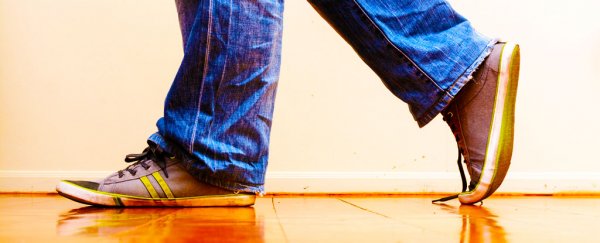Floorboards might not be the first form of renewable energy that springs to mind, but they could soon be taking their place alongside solar and wind power – because scientists have figured out a way to produce electricity from wood pulp.
Wood pulp is partly made of cellulose nanofibres, and with the right kinds of chemicals added, these nanofibres can actually produce a charge when they come into contact with untreated fibres.
The research, conducted by a team from the University of Wisconsin-Madison, means we could one day be powering lights and batteries simply from the force of our footsteps. And because wood pulp is a cheap and plentiful waste product from several industries, it wouldn't cost much, either.
"We've been working a lot on harvesting energy from human activities," explained lead researcher Xudong Wang. "One way is to build something to put on people, and another way is to build something that has constant access to people. The ground is the most-used place."
 Stephanie Precourt
Stephanie Precourt
The boards work by simply placing two differently charged materials next to each other – one being the treated cellulose nanofibres – each 1 millimetre or less thick.
When the materials come in contact with one another through the vibration of footsteps, electrons move from one layer to the other based on their opposite charges.
That in turn creates a charge imbalance. As the electrons attempt to rebalance themselves, they are passed through an external circuit, and energy is generated that we can use. Extra layers can be added to produce a higher energy output, Wang says.
These new floorboards are part of the team's research looking at the potential of triboelectric nanogenerators or TENGs – miniature generators making use of the way certain materials naturally create electric charges when they touch each other.
Static electricity (like when you rub a balloon on your clothes) is one of the best examples of this phenomenon. The same shift of electrons that happens between a balloon and a shirt is happening inside these wood pulp floors, and the new research shows that this energy can be trapped and put to use too.
Now Wang wants to build a prototype floor on the UW-Madison campus, to see how the technology works in practice.
As a renewable energy source, these floorboards wouldn't rely on weather conditions like bright sunlight or strong winds – just a lot of people passing by. And in the right environment, like a local mall or sports stadium, there's no shortage of pedestrians.
The team says their technology could eventually be built into many different types of floors, and used just about anywhere.
"Our initial test in our lab shows that it works for millions of cycles without any problem," said Wang. "We haven't converted those numbers into year of life for a floor yet, but I think with appropriate design it can definitely outlast the floor itself."
The findings have been published in Nano Energy.
